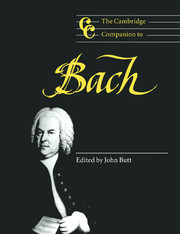Book contents
- Frontmatter
- Introduction
- Part I The historical context: society, beliefs and world-view
- 1 The Bach family
- 2 Bach and the domestic politics of Electoral Saxony
- 3 Music and Lutheranism
- 4 Bach's metaphysics of music
- 5 ‘A mind unconscious that it is calculating’? Bach and the rationalist philosophy of Wolff, Leibniz and Spinoza
- Part II Profiles of the music
- Part III Influence and reception
- Notes
- Select bibliography
- General Index
- Index of works
3 - Music and Lutheranism
from Part I - The historical context: society, beliefs and world-view
Published online by Cambridge University Press: 28 September 2011
- Frontmatter
- Introduction
- Part I The historical context: society, beliefs and world-view
- 1 The Bach family
- 2 Bach and the domestic politics of Electoral Saxony
- 3 Music and Lutheranism
- 4 Bach's metaphysics of music
- 5 ‘A mind unconscious that it is calculating’? Bach and the rationalist philosophy of Wolff, Leibniz and Spinoza
- Part II Profiles of the music
- Part III Influence and reception
- Notes
- Select bibliography
- General Index
- Index of works
Summary
Some understanding of the theological content and the liturgical practices of Lutheranism is essential for the historical appreciation of Bach's music. Bach's theological thinking was formed by the distinctively Lutheran responses to the Reformation debate of the sixteenth century, and he composed a great deal of his music for the Lutheran liturgies of his day. For example, the church cantatas usually relate in some way to the biblical readings, liturgical provisions, congregational hymnody, and ecclesiastical monody of the particular day, season or celebration. This chapter therefore outlines some of the distinctive features of the Lutheran Reformation in general, and Luther's musical and liturgical reforms in particular, as they relate both to later Lutheranism and to Bach's life and works.
The Reformation
Although it is customary to employ the term ‘Reformation’ as the ecclesiastical analogue of the ‘Renaissance’ of sixteenth-century Europe, it might be more accurate to speak of the ‘Reformations’ of the period. Although there were certainly a number of common concerns – such as the authority of the Bible in contradistinction to the authority of the church of Rome, or the concept of the general priesthood of all believers set against the particular priesthood of Catholicism – the Reformation in each European area developed its own characteristics, both theological and practical. Thus the Reformation in Switzerland, centred on such cities as Geneva, Basle and Zurich, was strongly influenced by the theology of such Reformers as Zwingli, Calvin and Bullinger.
- Type
- Chapter
- Information
- The Cambridge Companion to Bach , pp. 35 - 45Publisher: Cambridge University PressPrint publication year: 1997
- 26
- Cited by



